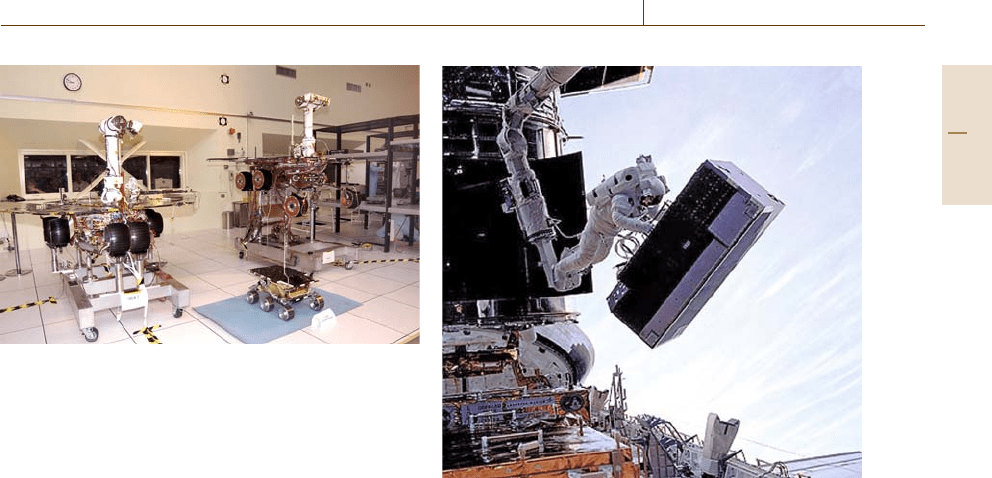Nof S.Y. Springer Handbook of Automation
Подождите немного. Документ загружается.


Flight Deck Automation 68.4 Flight Deck Automation in the Next-Generation Air-Traffic System 1235
•
Tight coupling between passenger demand, airpor-
tal infrastructure, aircraft operations, and air-traffic
control.
These capabilities are designed to allow the next-
generation system to handle two to three times the
capacity of the current system by 2025.
68.4.1 Network-centric Operations
Currently, most information in the air-traffic control
system is contained locally within each air-traffic con-
trol facility. The exception to this is the enhanced traffic
management system (ETMS) data, which is available
to all air-traffic control facilities and even users (with
a slight delay). However, ETMS data is significantly
limited in content and in update rate. Under future con-
cepts, all air-traffic information will be made available
(with some restrictions) to all agents in the system, in
order to facilitate better collaborative work. This con-
cept is referred to as network-centric operations.
The various air-traffic control authorities in different
countries are currently building the network infrastruc-
ture. This infrastructure will carry real-time flight plan
information and radar track information, which (in the
USA) is currently carried in the Department of Trans-
portation’s aircraft situation display to industry (ASDI)
data stream with one minute (at best) update rate, but
also may include such things as aircraft intent informa-
tion, scheduling information, aircraft load information,
airport and airspace capacity, and airline priority in-
formation. The ability to use this information should
provide unprecedented opportunities for automation de-
velopers.
For example, there has been little success in opti-
mizing sequences of aircraft into congested resources
such as airports. The current system allows aircraft to
launch when they want and fly at any speed to their
destination, where they may then have to be delayed
for tens of minutes or more. Moreover, decisions about
which aircraft get delayed are made based on a first-
come first-served basis.
While this can be considered at least fair (in that
no company gets an advantage from it), it is certainly
not optimal. It would be preferable to sequence aircraft
based on best throughput or least delay (for aircraft or
passengers). Without any information available in this
regard,it has been extremelydifficult to improve theair-
traffic system in this regard. With a single data source,
systems could consider many factors when deciding on
which aircraft to delay, and could start that delay early,
imposing small changes that have significant effects on
the overall system.
The methods to accomplish such optimizations have
not yet been developed. Some attempts at optimiza-
tion have been made, but are limited in scope. It is not
yet clear how one can formulate optimization problems
of this scope (or solve them in a reasonable period of
time). Moreover, whatever solutions are produced must
provide guidance on how to construct trajectories of
individual aircraft.
68.4.2 Future Air Vehicle Types
Decades ago it was believed by many that, by this
date, air travel would be dominated by supersonic trans-
ports. Due (in part) to noise and fuel consumption issues
that has not occurred, although research continues on
super- and hypersonic transports. As experts peer into
the future of air transportation, it is unclear what types
of vehicles will be present in the air-traffic system in
50years.
The last few years has seen a significant increase
in the use of small regional jets, due to their higher load
factor (i. e., higherpercentage of seats filledwith paying
customers). Airbus has also just introduced the A-380,
the largest passenger transport jet ever produced, with
seating for 550 to over 800passengers depending on the
configuration. Boeing is developing the B-787, a large
(210–330 passenger) jet with improved fuel economy,
flight deck systems,and passenger comfortfeatures. Re-
search is also being done on a lighter-than-air heavy lift
vehicle [68.93].
These designs are driven by projections of mar-
ket demand, and include systems driven by projections
of air-traffic control capabilities. There are also de-
sign interactionswith groundsystems, pilot training and
culture, emergency egress considerations, and so on.
Given the uncertainty in how far and how quickly fuel
prices will rise, how the demand for air service will
change, and how technology (both flight deck and air
traffic) will change, it is difficult to predict what vehi-
cles will be present in the air-traffic systems decades
from now.
However, research on the flight deck systems for
those vehicles must commence now if they are to be
ready for implementation when those vehicles undergo
development. Fortunately, the principles of safety and
efficiency will continue to drive the design of those
systems.
Part G 68.4

1236 Part G Infrastructure and Service Automation
68.4.3 Superdensity Operations
One of the major constraints on air-traffic growth is the
airspace surrounding the airport, referred to as the ter-
minal area. In the terminal area, the airspace is densely
crowded with aircraft whose positions are changing in
three dimensions, and whose rate of change of positions
is also changing. This greatly complicates the task of
pilots and controllers.
Tomorrow’s air-traffic system is being developed to
accommodate two to three times today’s traffic level.
This means even more dense terminal airspace. As
yet, there is no consensus as to how that will be ac-
complished. One possibility is that some or all of the
separation responsibility will be with the flight deck;
this will necessitate new automation to identify and re-
solve conflicts, while displaying information on these
conflicts and resolutions to the pilots.
In addition, pilots may be responsible for meeting
times-to-cross at various points along their route. While
current-generation FMS can accomplish this task, this
ability is brittle and is not conveyed well to pilots. As
this becomes a primary responsibility of pilots, this ca-
pability will have to be significantly enhanced.
Currently, efficient arrival procedures are being de-
veloped and tested at major airports across the globe.
These procedures are designed to reduce fuel use, emis-
sions, and noise simultaneously. Implementing such
procedures in superdense airspace will require addi-
tional technologies (such as flight deck displays of
traffic information, improved flight-deck-based conflict
detection and resolution, and intent broadcasting) and
more widespread use of existing technologies (such as
the global positioning system and autopilots coupled
with advanced flight management systems).
68.4.4 Integration
New systems will have to be integrated with ground-
based air-traffic systems as well as with legacy equip-
ment. Systems will also have to deal with a mix of
equipped, partially equipped, and unequipped aircraft.
It seems unlikely, given the burden of certification,
that completely new flight managementsystem software
will be developed. Instead, it is more likely that the new
capabilities will be added on top of the old software
with updated hardware. New automation will therefore
have to interface with old software, which was designed
for low-performance computing. In addition, many sys-
tems onboard aircraft are substantially unchanged from
decades ago, and provide their input to flight deck com-
puters. It is unlikely these systems will change either.
As new systems are developed, they are typically
expensive to implement. Therefore, many manufactur-
ers, airline companies, and individuals choose not to
implement them. This creates complexity, not only for
improving the system, but also for the use of flight deck
systems. For example, the TCAS system must work not
only between aircraft equipped with TCAS and mode S
transponders, but with those equipped only with a basic
transponder as well. This situation is likely to get worse
before it gets better – as new technologies come into the
market, there will be a wider disparity of capabilities
across aircraft.
68.5 Conclusion
Modern flight decks contain a large number of au-
tomation systems, including control, warning, and
information automation. Significant changes are be-
ing considered for air-traffic control systems, which
will influence automation systems for flight decks and
provide incredible opportunities for tomorrow’s au-
tomation engineer. These changes will have to balance
future needs, the increase in capabilities over the last
few (and next few) decades, the expense of advanced
automation, and the long lead times associated with the
development and certification of flight deck automa-
tion.
68.6 Web Resources
•
Eurocontrol Single European Sky:
http://www.eurocontrol.be/sesar
•
US Joint Planning and Development office:
http://www.jpdo.gov/
•
Federal Aviation Administration:
http://www.faa.gov/
•
NASA aeronautics:
http://www.aeronautics.nasa.gov/
Part G 68.6

Flight Deck Automation References 1237
•
Airbus:
http://www.airbus.com/
•
Boeing commercial airplanes:
http://www.boeing.com/commercial/
•
Honeywell labs:
https://www.honeywell.com/sites/htsl/
•
American Instituteof Aeronauticsand Astronautics:
http://www.aiaa.org
References
68.1 European Parliament: Laying down the framework
for the creation of the Single European Sky,Regu-
lation No. 549/2004 (2004)
68.2 Joint Planning and Development Office: Next Gen-
eration Air Traffic Control System Integrated Plan
(Joint Planning and Development Office, Washing-
ton 2004)
68.3 L.R. Newcome: Unmanned Aviation: A Brief History
of Unmanned Aerial Vehicles (AIAA, Washington
2004)
68.4 J. Broelmann: The development of the gyrocom-
pass - inventors as navigators, J. Navig. 51(2),
267–273 (1998)
68.5 P.M. Fitts: Human Engineering for an Effective Air-
Navigation and Traffic-Control System (National
Research Council Committee on Aviation Psychol-
ogy, Washington 1951)
68.6 http://mtp.jpl.nasa.gov/notes/pointing/
pointing.html
68.7 http://www.levelbust.com/articles/mode_s.htm
68.8 N.B. Sarter, D.D. Woods: Team play with a powerful
and independent agent: operational experiences
and automation surprises on the Airbus A-320,
Hum. Factors 39(4), 553–569 (1997)
68.9 Y.J. Tenney, W.H. Rogers, R.W. Pew: Pilot opin-
ions on high level flight deck automation issues:
toward the development of a design philosophy,
NASA Contract. Rep. 4669 (1995)
68.10 A. Degani, M. Shafto, A. Kirlik: Mode usage in au-
tomated cockpits: Some initial observations, Proc.
Int. Fed. Automat. Control; Man–Machine Syst.
(IFAC-MMS) Con. (IFAC, Boston 1995)
68.11 E.Palmer:“Oops,itdidn’tarm,ACaseStudyof
Two Automation Surprises”, Proc. 8th Int. Symp.
Aviat. Psychol., ed. by R.S. Jensen, L.A. Rakovan
(Columbus 1995)
68.12 H. Sogame, P. Ladkin: Aircraft Accident Investiga-
tion (Report 96-5) (Japan Ministry of Transport,
Tokyo 1996)
68.13 B.J. Carlson: Past UAV Program Failures and Im-
plications for Current UAV Programs (Report No.
AU/ACSC/037/2001-04) (Air University, Maxwell 2001)
68.14 National Transportation Safety Board: 14 CFR Part
121 Scheduled operation of Braniff Airways, Inc.
(Report No. DCA68A0005) (NTSB, Washington 1968)
68.15 National Transportation Safety Board: 14 CFR Part
121 Scheduled operation of Southern Airways, Inc.
(Report No. DCA77AA015) (NTSB, Washington 1977)
68.16 National Transportation Safety Board: 14 CFR Part
121 Scheduled operation of Eastern Airlines, Inc.
(Report No. DCA75AZ015) (NTSB, Washington 1975)
68.17 H.T. Liu, C. Golborne, Y. Bun, M. Bartel: Surface
windshear alert system, Part 1: Prototype develop-
ment, J. Aircr. 35(3), 422–428 (1998)
68.18 J.P. Bliss: Investigation of alarm-related accidents
and incidents in aviation, Int. J. Aviat. Psychol.
13(3), 249–268 (2003)
68.19 R. Parasuraman, V. Riley: Humans and automation:
use, misuse, disuse, abuse, Hum. Factors 39
(2),
230–253 (1997)
68.20 FAA: Introduction to TCAS II Version 7 (FAA, 2000)
68.21 http://humansystems.arc.nasa.gov/ihh/cdti/
cdti.html
68.22 D. Boorman: Today’s electronic checklists re-
duce likelihood of crew errors and help prevent
mishaps, ICAO Journal 1, 17–20 (2001)
68.23 D. Boorman: Today’s electronic checklists re-
duce likelihood of crew errors and help prevent
mishaps, ICAO Journal 1, 36 (2001)
68.24 A.L. Alexander, C.D. Wickens: Cockpit display of
traffic information: The effects of traffic load, di-
mensionality, and vertical profile orientation, 45th
Annu. Meet. Hum. Factors Ergon. Soc. (Santa Mon-
ica 2001)
68.25 R. Barhydt, R.J. Hansman: Experimental studies of
intent information on cockpit traffic displays, J.
Guid. Control Dyn. 22(4), 520–527 (1999)
68.26 W.W. Johnson, V. Battiste, S. Delzell, S. Holland,
S. Belcher, K. Jordan: Development and Demon-
stration of a Prototype Free Flight Cockpit Display
of Traffic Information, Proc. SAE/AIAA World Aviat.
Conf. (1997)
68.27 A.R. Pritchett, L.J. Yankosky: Simultaneous design
of cockpit display of traffic information and air
traffic management procedures, Proc. 19th DASC
(1998)
68.28 M.G. Ballin, J. Hoekstra, D. Wing, G. Lohr: NASA
Langley and NLR Research of Distributed Air/Ground
Traffic Management, Proc. 1st ATIO (2002)
68.29 P. Lee, J. Mercer, L. Martin, T. Prevot, S. Shelden,
S. Verma, N. Smith, V. Battiste, W. Johnson,
R. Mogford, E. Palmer: Free Maneuvering, Tra-
jectory Negotiation, and Self-Spacing Concepts in
Distributed Air-Ground Traffic Management, Proc.
5th USA/Europe Air Traffic Manag. R&D Semin. (Bu-
dapest 2003)
Part G 68

1238 Part G Infrastructure and Service Automation
68.30 M.W. McGreevy, S.R. Ellis: The effect of perspective
geometry on judged direction in spatial informa-
tion instruments, Hum. Factors 28,439–456(1986)
68.31 D.D. Woods: Visual momentum: A concept to
improve the cognitive coupling of person and com-
puter, Int. J. Man–Mach. Stud. 21, 229–244 (1984)
68.32 O. Olmos, C.D. Wickens, A. Chudy: Tactical displays
for combat awareness: An examination of dimen-
sionality and frame of reference concepts, and
the application of cognitive engineering, 9th Int.
Symp. Aviat. Psychol. (Columbus 1997)
68.33 S.N. Roscoe: Aviation Psychology (Iowa State Univ.
Press, Ames 1981)
68.34 J.L. Levy, D.C. Foyle, R.S. McCann: Performance
benefits with scene-linked HUD symbology: An at-
tentional phenomenon?, 52nd Annu. Meet. Hum.
Factors Ergon. Soc. (Santa Monica 1998)
68.35 P.M. Ververs, C.D. Wickens: Head-up displays:
effect of clutter, display intensity, and display lo-
cation on pilot performance, Int. J. Aviat. Psychol.
8(4), 377–403 (1998)
68.36 C.D. Wickens, T. Prevett: Exploring the dimensions
of egocentricity in aircraft navigation displays, J.
Exp. Psychol. Appl. 1(2), 110–135 (1995)
68.37 C.M. Bjorklund, J. Alfredson, S.W.A. Dekker: Mode
monitoring and call-outs: an eye-tracking study of
two-crew automated flight deck operations, Int. J.
Aviat. Psychol. 16(3), 263–275 (2006)
68.38 J. Bredereke, A. Lankenau: Safety-relevant mode
confusions – modelling and reducing them, Reliab.
Eng. Syst. Saf. 88(3), 229–245 (2005)
68.39 A. Degani, M. Heymann: Formal verification
of human-automation interaction, Hum. Factors
44(1), 28–43 (2002)
68.40 S.S. Vakil, J.R. Hansman: Approaches to mitigating
complexity-driven issues in commercial autoflight
systems, Reliab. Eng. Syst. Saf. 75(2), 133–145 (2002)
68.41 R.L. Ennis, Y.J. Zhao: A formal approach to analysis
of aircraft protected zone, Air Traffic Control Q. 12(1),
75–102 (2004)
68.42 S.J. Landry, A.R. Pritchett: Examining assumptions
about pilot behavior in paired approaches, Int.
Conf. Human-Comput. Interact. Aeronaut. (Cam-
bridge 2002)
68.43 A.R. Pritchett, R.J. Hansman: Pilot non-conformance
to alerting system commands during closely spaced
parallel approaches, Proc. 16th DASC (1997)
68.44 T.S. Abbott, G.C. Mowen, L.H. Person Jr., G.L. Keyser
Jr., K.R. Yenni, J.F. Garren Jr.: Flight investigation
of cockpit-displayed traffic information utilizing
coded symbology in an advanced operational en-
vironment (NASA Tech. Paper 1684) (NASA Langley
Research Center, Hampton 1980)
68.45 J.K. Kuchar, L.C. Yang, C. Mit: A review of con-
flict detection and resolution modeling methods,
Intell. Transp. Syst. IEEE Trans. 1(4), 179–189 (2000)
68.46 L.F. Winder, J.K. Kuchar: Evaluation of collision
avoidance maneuvers for parallel approach, J.
Guid. Control Dyn. 22(6), 801–807 (1999)
68.47 L.C. Yang, J.K. Kuchar: Prototype conflict alerting
system for free flight, J. Guid. Control Dyn. 20(4),
768–773 (1997)
68.48 C.D. Hansen, C.R. Johnson: The Visualization Hand-
book (Elsevier, Burlington 2005)
68.49 T. Munzner, C. Johnson, R. Moorhead, H. Pfister,
P. Rheingans, T.S. Yoo: NIH-NSF visualization re-
search challenges report summary, IEEE Comput.
Graph. Appl. 26(2), 20–24 (2006)
68.50 M.R. Endsley, E.O. Kiris: The out-of-the-loop
performance problem and level of control in au-
tomation, Hum. Factors 37(2), 381–394 (1995)
68.51 C.E. Billings: Aviation Automation: The Search for
a Human-Centered Approach (Lawrence Erlbaum,
Mahwah 1997)
68.52 D.B. Kaber, M.R. Endsley: The effects of level of
automation and adaptive automation on human
performance, situation awareness and workload
in a dynamic control task, Theor. Issues Ergon. Sci.
5(2), 113–153 (2004)
68.53 C.A. Miller, H.B. Funk, R. Goldman, J. Meisner,
P. Wu: Implications of adaptive versus adapt-
able UIs on decision making: Why “automated
adaptiveness” is not always the right answer,
Proc. 1st Int. Conf. Augment. Cogn. (Las Vegas
2005)
68.54 National Transportation Safety Board: 14 CFR Part 121
Scheduled operation of United Airlines, Inc. (Report
No. DCA89MA063) (NTSB, Washington 1989)
68.55 T.B. Sheridan: Telerobotics, Automation, and Hu-
man Supervisory Control (MIT Press, Cambridge
1992)
68.56 L. Bainbridge: Ironies of automation, Automatica
19(6), 775–780 (1983)
68.57 D.A. Norman: The "problem" with automa-
tion: inappropriate feedback and interaction, not
"over-automation", Philos. Trans. R. Soc. Lond.
Ser. B Biol. Sci. (1934–1990) 327(1241), 585–593
(1990)
68.58 M.J. Adams, Y.J. Tenney, R.W. Pew: Situation
awareness and the cognitive management of com-
plex systems, Hum. Factors: J. Hum. Factors Ergon.
Soc. 37(1), 85–104 (1995)
68.59 M.R. Endsley, D.B. Kaber: Level of automation ef-
fects on performance, situation awareness and
workload in a dynamic control task, Ergonomics
42(3), 462–492 (1999)
68.60 F.I.M. Craik, E. Tulving: Depth of Processing and the
Retention of Words in Episodic Memory. Cognitive
Psychology: Key Readings (Psychology, New York
2004)
68.61 B. Kirwan, L.K. Ainsworth: AGuidetoTaskAnalysis
(Taylor & Francis, New York 1992)
Part G 68

Flight Deck Automation References 1239
68.62 M.R. Endsley, B. Bolté, D.G. Jones: Design-
ing for Situation Awareness: An Approach to
User-Centered Design (Taylor & Francis, London
2003)
68.63 M. Yeh, J.L. Merlo, C.D. Wickens, D.L. Branden-
burg: Head up versus head down: the costs of
imprecision, unreliability, and visual clutter on cue
effectiveness for display signaling, Hum. Factors
45(3), 390–408 (2003)
68.64 M.S. John, D.I. Manes, H.S. Smallman, B.A. Feher,
J.G. Morrison: Heuristic automation for declutter-
ing tactical displays, Proc. Hum. Factors Ergon. Soc.
48th Annu. Meet. (Human Factors and Ergonomics
Society, Santa Monica 2004)
68.65 P. Kroft, C.D. Wickens: Displaying multi-domain
graphical database information: An evaluation of
scanning, clutter, display size, and user activity:
Information design for air transport, Inf. Des. J.
11(1), 44–52 (2002)
68.66 J.W. Ruffner, M.C. Lohrenz, M.E. Trenchard: Human
factors issues in advanced moving-map systems, J.
Navig. 53(01), 114–123 (2000)
68.67 W. Lutters, M. Ackerman: Achieving Safety: A Field
Study of Boundary Objects in Aircraft Technical Sup-
port, CSCW ’02 (New Orleans 2002)
68.68 S.L. Star, J.R. Griesemer: Institutional ecology,
‘translations’, and boundary objects: Amateurs
and professionals in Berkeley’s Museum of Verte-
brate Soology, Soc. Stud. Sci. 19, 387–420 (1989)
68.69 C.E. Shannon: Communication in the presence of
noise, Proc. IEEE 72(9), 1192–1201 (1984)
68.70 J.W. Senders: The human operator as a monitor
and controller of multidegree of freedom systems.
In: Ergonomics: Major Writings,ed.byN.Moray
(Taylor & Francis, New York 2005)
68.71 N. Cowan: The magical number 4 in short-term
memory: A reconsideration of mental storage ca-
pacity, Behav. Brain Sci. 6, 21–41 (2000)
68.72 G.A. Miller: The magical number seven, plus or mi-
nus two: Some limits on our capacity for processing
information, Psychol. Rev. 63, 81–97 (1956)
68.73 K. Koffka: Principles of Gestalt Psychology (Har-
court, Orlando 1967)
68.74 E.J. McCormick, M.S. Sanders: Human Factors in
Engineering and Design (McGraw-Hill, New York
1982)
68.75 P.M. Fitts, R.E. Jones, J.L. Milton: Eye movements
of aircraft pilots during instrument-landing ap-
proaches. In: Ergonomics: Major Writings,ed.by
N. Moray (Taylor & Francis, New York 2005)
68.76 W.J. Horrey, C.D. Wickens, K.P. Consalus: Modeling
drivers’ visual attention allocation while interact-
ing with in-vehicle technologies, J. Exp. Psychol.
Appl. 12(2), 67–78 (2006)
68.77 M.A. Recarte, L.M. Nunes: Mental workload while
driving: Effects on visual search, discrimination,
and decision making, J. Exp. Psychol. Appl. 9(2),
119–137 (2003)
68.78 E.M. Rantanen, J.H. Goldberg: The effect of men-
tal workload on the visual field size and shape,
Ergonomics 42(6), 816–834 (1999)
68.79 H.Z. Tan, R. Gray, J.J. Young, R. Traylor: A haptic
back display for attentional and directional cueing,
Haptics-e 3(1), 1–20 (2003)
68.80 J. Rasmussen: Skills, rules, and knowledge; signals,
signs, and symbols, and other distinctions in hu-
man performance models, Syst. Des. Hum. Interact.
Table of Contents (1987) pp. 291–300
68.81 P.A. Hancock, G. Williams, C.M. Manning: Influ-
ence of task demand characteristics on workload
and performance, Int. J. Aviat. Psychol. 5(1), 63–86
(1995)
68.82 K.H. Kroemer: Avoiding cumulative trauma disor-
ders in shops and offices, Am. Ind. Hyg. Assoc. J.
53(9), 596–604 (1992)
68.83 H.B. Kroemer: Ergonomics: How to Design for Ease
and Efficiency (Prentice Hall, Englewood Cliffs 1994)
68.84 M.R. Lehto, J.R. Buck: Introduction to Human
Factors and Ergonomics for Engineers (Lawrence
Erlbaum, New York 2007)
68.85 H.R. Blackwell: Development and use of a quan-
titative method for specification of interior illu-
minating levels on the basis of performance data,
Illum. Eng. 54, 317–353 (1959)
68.86 R.P. Hemenger: Intraocular light scatter in normal
vision loss with age, Appl. Opt. 23, 1972–1974 (1984)
68.87 J.Edworthy,A.Adams:Warning Design: A Research
Prospective (Taylor & Francis, London 1996)
68.88 E.M. Clarke, J.M. Wing: Formal methods: state of
the art and future directions, ACM Comput. Surv.
(CSUR) 28(4), 626–643 (1996)
68.89 J. Cheesman, J. Daniels: UML Components: A Simple
Process for Specifying Component-Based Software
(Addison-Wesley, Reading 2000)
68.90 J.P. Bowen, M.G. Hinchey: Seven more myths of
formal methods, Softw. IEEE 12(4), 34–41 (1995)
68.91 N.G. Leveson: Safeware: System Safety and Com-
puters (Addison-Wesley, Reading 1995)
68.92 Federal Aviation Administration: Certification of
Transport Airplane Mechanical Systems (AC 25-22)
(FAA, Washington 2000)
68.93 A. Colozza: Initial Feasibility Assessment of a High
Altitude Long Endurance Airship (Report No.
NASA/CR—2003-212724) (NASA, Washington 2003)
Part G 68
“This page left intentionally blank.”

1241
Space and Ex
69. Space and Exploration Automation
Edward Tunstel
Space-faring nations are actively exploring outer
space and planetary bodies in our solar system
both individually and as collaborators with other
nations. In most endeavors, the inherent risk to
human life has been mitigated by the use of au-
tomation and robotics to conduct space missions.
Missions extending from low-Earth orbit to Earth’s
moon and beyond to destinations throughout the
solar system have been successfully conducted.
Robots and human astronauts assisted by auto-
mated systems have been used on space missions.
Infrastructure and service automation in the con-
text of space missions are discussed in this chapter.
Automation and robotics have played a substantial
role in installing space exploration infrastructure
such as Earth-orbiting satellites and space stations
occupied for extended periods by astronauts as
well as satellites that operate for extended periods
in orbit around other planets. General background
information about automation and robotics for
exploration of space is presented. Challenges of
applying automation in space and planetary envi-
ronments are highlighted for robots that operate
in Earth orbit, at the Moon, at Mars, and other
69.1 Space Automation/
Robotics Background ............................1242
69.2 Challenges of Space Automation ............1243
69.2.1 Sensing and Perception
for Manipulation and Mobility ..... 1244
69.2.2 On-Orbit and In-Space Robotics... 1246
69.2.3 Subsurface Robotics.................... 1247
69.2.4 Automation ............................... 1248
69.3 Past and Present Space Robots
and Applications ..................................1248
69.4 Future Directions and Capability Needs...1250
69.5 Summary and Conclusion ......................1251
69.6 Further Reading ...................................1251
References ..................................................1252
destinations. A look forward to what the fu-
ture will hold for further space and exploration
automation is provided, including mention of ad-
vancements in technological capabilities that will
be needed to accomplish more ambitious space
missions.
A wide variety of solutions to many problems in mili-
tary and civil space programs are being addressed using
some level of automation and robotics. Automation and
robotics is personified by the synthesis and application
of integrated electromechanical and computer systems
that perform useful functions for engineering, science,
or industrial applications. Space agencies around the
world employ robotic systems instrumented with a va-
riety of sensors and tools as surrogate explorers and
automated workers on-orbit, as assistants to astronauts,
on remote planetary surfaces, and throughout the solar
system. Their systems and missions provide the in-
frastructure and service automation that enables access
to space and planet destinations throughout our solar
system.
Of particular relevance to automation for space ex-
ploration are sensing, perception, and control issues
associated with operations in space environments and
limited support from humans. These issues are rele-
vant in the context of challenges associated with robotic
tasks required for a variety of space missions. Some
missions are purely focused on scientific discovery.
Other missions may require building physical infras-
tructure for human activity in space. Still others may
aim to provide sustenance for humans in eventual
habitats away from Earth.In allsuch cases, sensing,per-
Part G 69

1242 Part G Infrastructure and Service Automation
ception, and control issues are relevant for automated
and robotic solutions. Applications to future space mis-
sions will involve automated exploration, service, and
construction tasks to be performed on orbiting space
stations, in planetary atmospheres, as well as on and
beneath planet surfaces.
Space robots are used to automate tasks in space en-
vironments when simpler or less expensive automation
solutions are infeasible. The decision to employ robots
to automate execution of certain tasks must consider
task complexity, constraints of space environments, and
an array of certain and potential risks involved. The re-
quired level of system autonomy may also dictate the
applicability ofautomation and robotic solutions for use
on space missions. Combinations and various levels of
hardware, software, andcontrol provided byhumans are
brought to bear to perform successful space missions.
The relative allocation of task or mission functionality
to hardware, software, and humans provides a sense for
the degree of automation employed by a given system.
In the remainder of this chapter, space and explo-
ration automation is discussed through the presentation
of background thoughts about the field and challenges
that define the complexity of space operations for
automation and robotics as well as highlights of rep-
resentative space robots and their applications. Some
future directions and technological capabilities needed
for future space missions are also noted.
69.1 Space Automation/Robotics Background
Automated systems and robots serve a variety of pur-
poses in space environments whether sharing, augment-
ing, or extending human activity. Examples include
transporting scientific instruments and equipment to
space destinations for deployment and operation. They
serve as substitutes for human presence in hostile space
environments that are inaccessible to humans or diffi-
cult for humans to work safely and efficiently within.
Like similar automation systems used on Earth, space
automation and robotic systems are also useful for per-
Fig. 69.1 The European Space Agency’s (ESA) XMM-
Newton is the most sensitive x-ray telescope ever built. Its
high-technology design uses over 170 wafer-thin cylindri-
cal mirrors spread over three telescopes. This unique x-ray
observatory was launched by Ariane 5 from the European
spaceport at Kourou in French Guiana on 10 December
1999 (courtesy of ESA)
forming mundane or repetitive tasks that allow humans
to focus on more deliberative, cognitive or otherwise
complex tasks. Space automation and robotics also
facilitates the creation, delivery, and operation of sci-
entific, commercial, and military assets in space, thus
enabling the existence and use of facilities that are un-
available or infeasible on Earth (e.g., space telescopes
(Fig.69.1), interplanetary probes, and space laborato-
ries such as the International Space Station and the
Russian Mir Space Station).
Robotic space systems are typically supported
by human and computer systems on Earth that fa-
cilitate their control and operation. Human mission
controllers/operators on Earth utilize a comprehensive
collection of computer systems, scientific data and in-
formation, and in particular software tools that aid
decision making. This so-called ground data system
represents the connectivity and flow of data and infor-
mation on Earth as opposed to communication links
between Earth and spacecraft in flight or at other plan-
ets. It encompasses networks of antennae used for
continuous spacecraft tracking [such as the National
Aeronautics and Space Administration (NASA) Deep
Space Network – a worldwide spacecraft tracking fa-
cility managed and operated by NASA’s Jet Propulsion
Laboratory], facilities that provide communications
between the antennae and the locations conducting
mission control/operations activities, and a system of
computers, software, networks, andprocedures that pro-
cess spacecraft data.
Robotic spacecraft share subsystems that serve or
perform the following common functions [69.1–4]:
Part G 69.1

Space and Exploration Automation 69.2 Challenges of Space Automation 1243
Fig. 69.2 The twin rovers of the Mars Exploration Rover
Mission pose with their ground-breaking predecessor, the
flight spare of the Sojourner rover from NASA’s 1997
Pathfinder mission (courtesy of NASA Jet Propulsion Lab-
oratory)
propulsion or locomotion,attitude control, power gener-
ation and distribution, structural integrity, thermal con-
trol, communications, command and data handling, and
accommodation of mission-specific payloads. The com-
mand and data handling subsystem typically includes
a programmable computer that enables automation of
a variety of tasks. The types of robotic spacecraft em-
ployed in past and current space missions include flyby
spacecraft, orbiter spacecraft, atmospheric probe space-
craft, penetrator spacecraft, lander and surface rover
spacecraft (Fig. 69.2), observer spacecraft, and com-
munications/navigation spacecraft. This classification
is based primarily on functional spectrum of robotic
spacecraft mission types. A subset of past and current
spacecraft include or carry robotic mechanisms that in-
teract physically with the target environment through
manipulation or mobility such as wheeled or legged
ground vehicles, and robots with manipulator arms and
gripping end-effectors.
The current state of the art for space automa-
tion and robotics is limited by the rate of technology
development, budgets for the same, and inherent con-
servatismin space mission risk management as it relates
to automation. On-orbit tasks such as space structure
assembly, inspection, and maintenance are presently
Fig. 69.3 Astronaut servicing the Hubble Space Telescope
while secured by foot restraints to the end of the Canadarm
(Space Shuttle Remote Manipulator System)
limited to collaborative astronaut and telerobotic exe-
cution approaches. For the past two decades, the NASA
Space Shuttle Orbiter with Canada’s Remote Manipu-
lator System (Canadarm) has assisted astronauts with
successful on-orbit servicing tasks such as satellite re-
trieval, repair, and rescue. This includes servicing of
the Hubble Space Telescope involving critical parts
replacement and instrument upgrades (Fig.69.3). The
level and success of automation is increasing, however,
with recent use of the Canadarm (with a boom that ex-
tends its reach) to assist with visual on-orbit inspection
of heat shield tiles on the underside of the Space Shuttle
Orbiter in 2006, and with a recent successful demon-
stration of autonomous on-orbit fuel and battery transfer
from one spacecraft to another in 2007. The latter was
performed bythe Boeing Orbital Express system, which
consists of an autonomous on-orbit servicing spacecraft
and a serviceable client spacecraft. Surface rovers are
reasonably advanced in autonomy but currently limited
to autonomous traversal of hundreds of meters per day
over relatively benign terrain.
69.2 Challenges of Space Automation
Space systems are subject to strict limitations on power,
communications, data processing, and hardware re-
sources in general, not to mention mass and volume.
Sensor devices and systems, in particular, must comply
Part G 69.2

1244 Part G Infrastructure and Service Automation
with certain specifications of size and payload capac-
ity, onboard power availability, thermal limitations, and
solar radiation tolerance. Such constraints are imposed
by characteristics of the target space environment and
mission objectives among other things, such as the rig-
ors of space travel. In addition, electronics (including
associated embedded computing) should be qualified to
survive and operate withinthe harshtemperature andra-
diation extremes of outer space and similar extremes on
planet surfaces with thin atmospheres (such as Mars).
Mechanical assemblies and components with few or
no moving parts are preferred since they stand a bet-
ter chance of surviving the vibration and gravity forces
of spacecraft launch, atmospheric entry, and landing as-
sociated with robotic flights from Earth to other planet
surfaces. The nature of certain space missions or sheer
distances to their destinations require robotic space-
craft to operate on their own for extended time frames
without communication with human mission operators.
Thus, certain levels of autonomy are required.
A fundamental challenge of robotic automation in
space and on-orbit is the need to operate in micrograv-
ity wherein the effects of forces are quite different than
in Earth gravity. Robotic operations in space are char-
acterized by slow motions that facilitate compensation
for undesired forces and moments due to micrograv-
ity. Robot manipulator arms and mechanisms typically
utilize computer-vision-based perception, proximity
sensors (based on infrared or electrical capacitance,
for example), and force/torque sensors to achieve gross
and fine manipulation. Dexterity for the latter is often
enabled by additional mechanical degrees of freedom
and/or advanced automatic control techniques. The
same is true for manipulation mechanisms affixed to
mobile robotic platforms.
Navigation by mobile robotic platforms, or rovers,
on planet surfaces presents several challenges. Rovers
must be able to detect hazards and assess thetraversabil-
ity of the terrain. Additional problems to be addressed
for navigation include maintaining knowledge of rover
pose (three-dimensional (3-D) position and 3-D orien-
tation), as well as stability and traction as it traverses
terrain or maps the local environment and prominent
landmarks relevant to the mission. Sensing and per-
ception for mobility and navigation are essential for
missions requiring land reconnaissance or survey for
the purpose of scientific exploration as well as for site
construction and operations. A variety of sensors are
commonly employed to measure rover motions, posi-
tion with respect to the environment, and the presence
of or range to mobility obstacles. Existing sensor types
are as varied as the physical phenomena underlying
their operation (e.g., optical, inertial, magnetic). De-
spite the large variety of available sensor technologies,
planetary rover sensor systems are often restricted to
few types due to limitations and/or constraints related
to mass, volume, power, and operability/survivability in
space environments; for example, on Earth, a common
sensor for position estimation and localization is the
satellite-based global positioning system (GPS), which
provides accurate outdoor position knowledge in terrain
where sufficient reception of signals from Earth satel-
lites can be achieved. Orbiting satellites at Mars that
have sensors of sufficient spatial resolution may be used
to facilitate rover position, but no existing analogue to
Earth’s GPS is available at Mars yet. This is a major
limiting factor of localization accuracy achievement for
rover systems there. Robust surface navigation requires
accurate headingmeasurement or very goodheading es-
timation. Errors in heading estimates directly affect the
accuracy of rover position estimates. Optical encoders,
potentiometers, or resolvers are often used to measure
revolutions of robot wheels. Such measurements allow
heading and position estimation via dead reckoning or
wheel odometry (based on the robot kinematics) relative
to some known starting position and heading. However,
in rough and rugged outdoor terrain these estimates are
only reliable over short distances. Thus, for long-range
traverses, morereliable headinginformation is required.
To achieve this, Earth-based robots often employ mag-
netic devices, such as compasses, which provide good
absolute heading measurements with respect to true
north of Earth’s magnetic field. Magnetic heading sen-
sors are not as useful on Mars, however, due to the
planet’s negligible magnetic field.
Some of the key technical areas receiving focused
attention by the space automation developers include:
sensing and perception, robotics on-orbit, in-space, and
subsurface as wellas increasedautomation ofspace sys-
tems in general. Key points in each of these areas are
discussed in turn below.
69.2.1 Sensing and Perception
for Manipulation and Mobility
Modeling, simulating, and/or predicting the functional
behavior of orbiter and flyby spacecraft is facilitated by
reasonably well-behaved dynamics and operating envi-
ronments. For such robotic spacecraft, conventional es-
timation and control techniques have similar effects on
spacecraft behavior in simulation as they do in reality.
This is due to the fact that the physical laws of orbital
Part G 69.2
